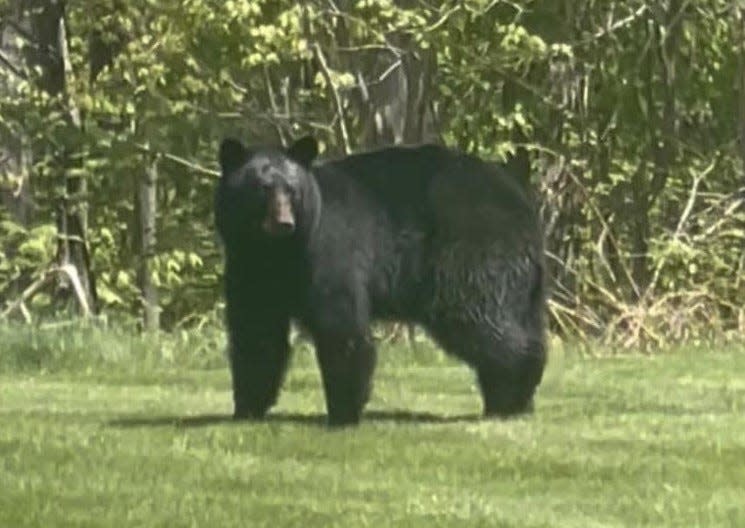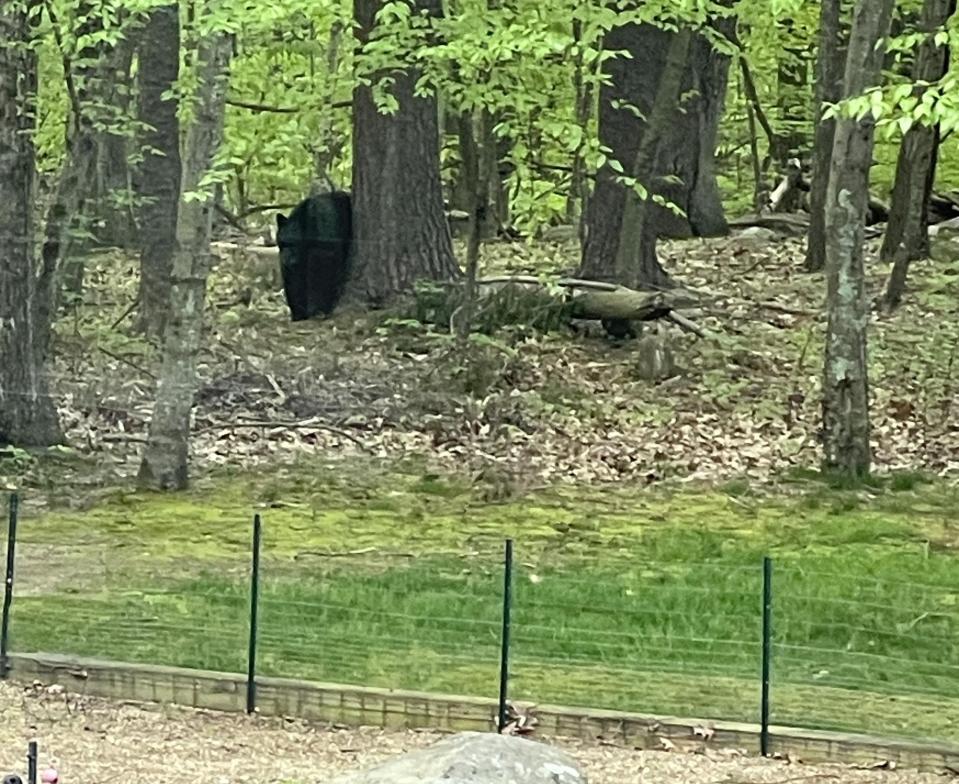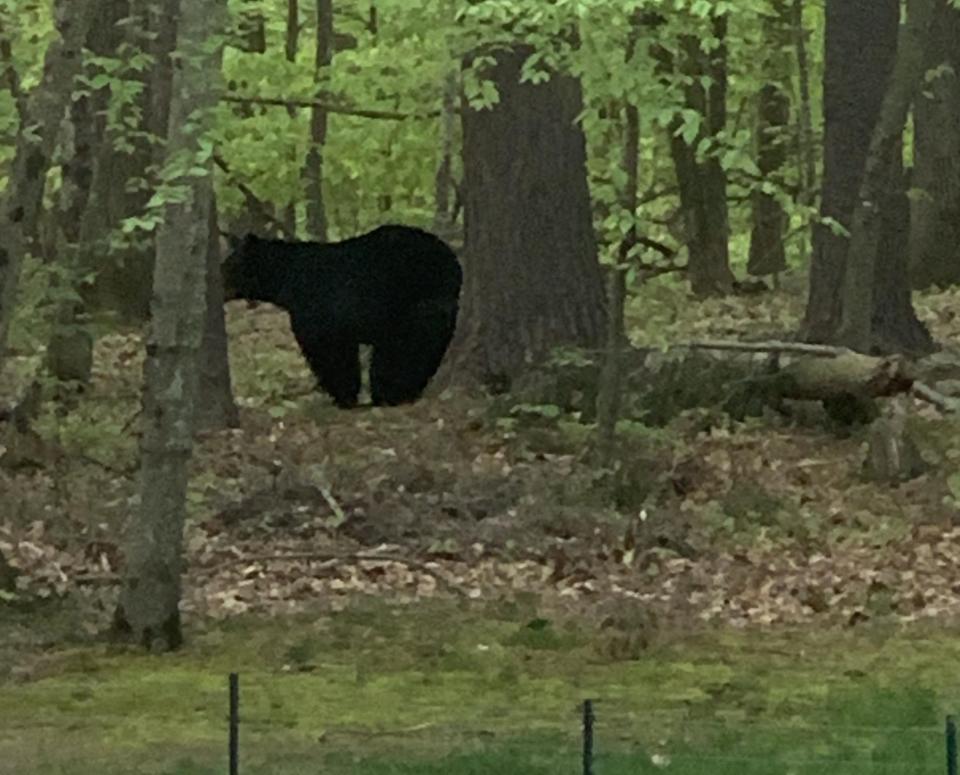Mother bear and cubs spotted roaming Exeter neighborhoods
EXETER — A mother bear and her two cubs have been frequent visitors to several neighborhoods on the west side of town in recent weeks, and state wildlife officials say it’s time for residents to take down their bird feeders.
The bears have been seen on Blackford Place, Eno Drive, Greenleaf Drive, the Jolly Rand Road trail, which are off Route 111A and on Cottage Street, which is off Route 111. They’ve also been spotted on home security cameras on Pickpocket Road, which goes from Route 111 to Route 111A.

New Hampshire Fish and Game officials say there is no need for alarm, but residents should be proactive by taking down bird feeders and not storing trash outside. Fish and Game recommends that people remove their bird feeders from April 1 through December 1, though in recent milder winters, they might suggest pulling them down by mid-March.
“These bears are not dangerous, they’re not a threat, but they’re somewhat novel to people in that part of the state,” said Andrew Timmins, game programs supervisor for New Hampshire Fish and Game. “People do not need to stop using the outdoors or feel threatened or scared. It’s just another one of New Hampshire’s wild animals that we have here.”
The bears have likely been out of hibernation for the past month and a half to two months and are looking for more calorie-dense food while they await the arrival of summer fruit crops.
“When they come out in the spring, food is kind of limited as a big part of a bear’s diet is fruit crops, but we don’t start getting our first fruit crops in the state until really mid to late June,” Timmins said. “So, prior to that, these bears are eating vegetation, which will keep them going as a filler, but they’re hungry. They’re trying to replenish body fat (after hibernation) and given the choice between herbaceous vegetation or bird seed or garbage, they’re going to gravitate to those higher calorie foods every time.”
Emotional reunion: Plumber thanks Exeter firefighter for saving his life
Bears in the neighborhood
Bonnie Ward, who lives in Blackford Place, has been aware that a bear has lived in her area for a few years, but this year is the first time she’s seen it up close. She usually walks her dog to her regular coffee meeting with a neighbor on Eno Drive, but when she heard there was a bear in his yard last week, she drove instead.
“Thank God I didn’t walk over because I probably would have had a heart attack,” she said. “When I got into his driveway, the bear sat up, like who’s this, but she didn’t move.”
Once inside, she was able to watch the bear from the kitchen window. “It’s really exciting, I have to admit that. We have had this bear for the past two to three years and I have never actually seen it,” she said. “It was fascinating. As soon as her babies started coming down the tree, she just moseyed away.”

Ward said her neighborhood sent our information to its residents to let them know about the bear and offer some tips such as bringing in bird feeders, not putting trash out the night before pick up, and to be aware of their surroundings.
“Mostly what we do is try to be alert. When my daughter walks the dog, she stays away from the more heavily forested area,” Ward said. “We have invaded their space, so you just try to be respectful. If you leave them alone and you don’t have food out, they will go away.”
Shana Hoch, who lives off Pickpocket Road, first heard about the bear when her neighbors shared a video of it snagging their suet. “At first I thought it was a joke,” Hoch said. “We’ve lived off of Pickpocket Road not far from Route 111 for over 10 years, and I’ve never heard of any bear sightings close by.”
That prompted her to check their home security cameras. “And sure enough, the bear had walked across our property within 10 feet of the back of the house about 30 minutes before I let the dog out,” she said. “I’m definitely paying a lot closer attention when I walk outside, especially when I take out the dog early in the morning and late at night.”
Special honor: Exeter’s Greg Bisson honored with top NH Parks and Recreation award
What to do if you encounter a bear?
Some people add a bell to their dog’s collar while in the woods, which Timmins said adds to normal trail noise that keeps bears away. He cautioned that unleashed or protective canines might inadvertently land in a situation with a bear.
“We do not have instances where bears come into yards and attack dogs, that’s just not reality,” he said. “What can happen if you have a dog that can be aggressive and go after a bear, sometimes the bear will swat it in defense.”
Those who have backyard chickens should be cautious because bears will eat chickens if given the chance. “Keep your chickens secured and consider an electric fence,” Timmins said. “Some bears will be attracted to the chicken coop due to the grain, but they absolutely will eat chickens.”

So, what should you do if you encounter a bear? “The first thing you should do is enjoy the opportunity to see a bear, you don’t see them every day,” he said. “If you’re out walking this trail and see a bear at a distance, make normal trail noise to alert the bear to your presence.”
Normally, that’s enough to send the bear walking away. If for some reason you find yourself close to a bear, for example, you round a corner and the bear is there, don’t panic.
“We recommend just calm talking, maintaining eye contact, talking ‘Hey bear, I’m here bear.’ You’re letting the bear know you’re not a threat,” Timmins said. “Under most normal circumstances they’ll hear you or smell you and they’re going to be gone.”
They sell a little bit of ‘everything’: New England Mercantile to add second shop in Exeter
The normal range of a female bear is six to eight square miles but that can vary depending on food availability and the cubs. With cubs, Timmins said this bear is likely going much less distance, but also needs more food because of the young cubs.
Bear spray is intended for situations where you’re “pretty sure there’s a chance you’re going to be attacked” which would be out west with a different type of bear. “The bear spray is really unnecessary,” Timmins said. “A better thing would be to carry one of the pressurized air horns.”
While some who have seen the bear worry that having the two cubs might make her more aggressive, Timmins said that’s not necessarily the case.
“If she felt there was potential danger, she’s going to tell her cubs to go up a tree and she’s often going to just sit at the base of the tree,” he said. She might even climb to a lower branch. “She’s keeping an eye on them and she’s making sure there’s no danger. You just give them space.”
This article originally appeared on Portsmouth Herald: Exeter NH bear sightings: Mother bear and cups roaming neighborhood

